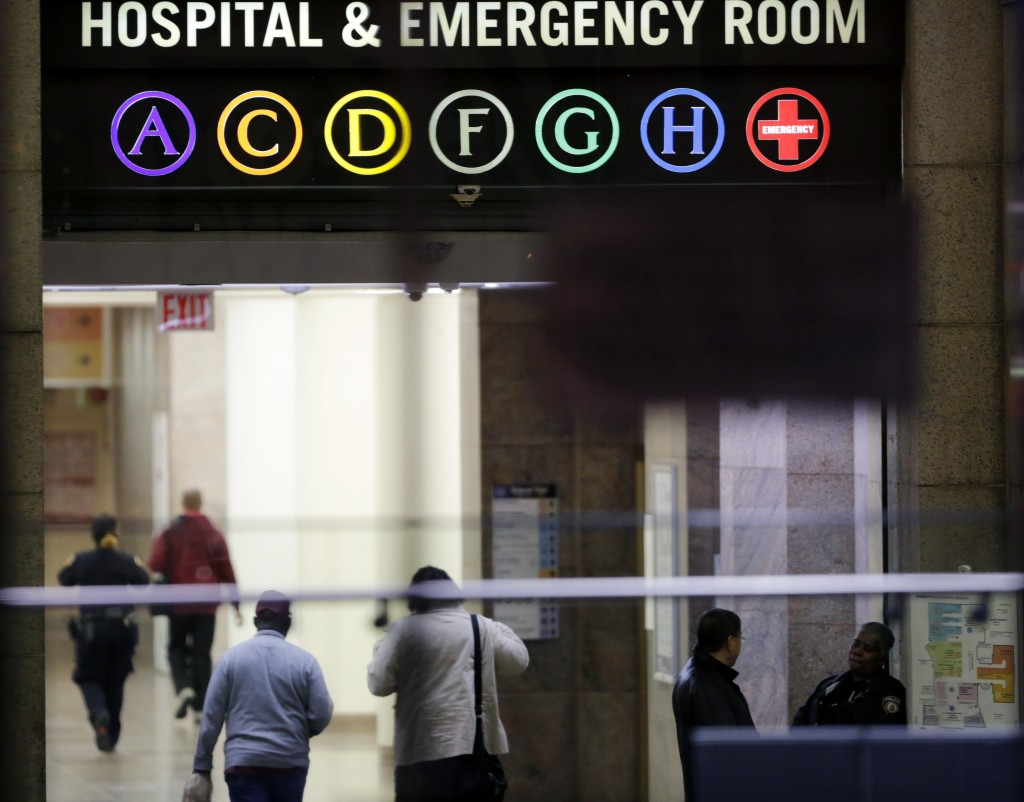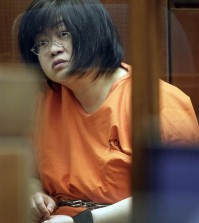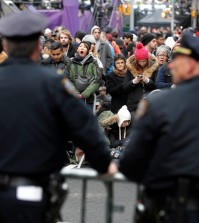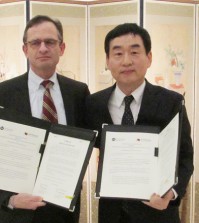- California Assembly OKs highest minimum wage in nation
- S. Korea unveils first graphic cigarette warnings
- US joins with South Korea, Japan in bid to deter North Korea
- LPGA golfer Chun In-gee finally back in action
- S. Korea won’t be top seed in final World Cup qualification round
- US men’s soccer misses 2nd straight Olympics
- US back on track in qualifying with 4-0 win over Guatemala
- High-intensity workout injuries spawn cottage industry
- CDC expands range of Zika mosquitoes into parts of Northeast
- Who knew? ‘The Walking Dead’ is helping families connect
NYC tries to ease Ebola fear after doctor is infected

People walk through the lobby of Bellevue Hospital, Friday, Oct. 24, 2014, in New York. Dr. Craig Spencer, a resident of New York City and a member of Doctors Without Borders, was admitted to Bellevue on Thursday and has been diagnosed with Ebola. (AP Photo/Mark Lennihan)
NEW YORK (AP) — Officials tried to tamp down New Yorkers’ fears Friday after a doctor was diagnosed with Ebola in a city where millions of people squeeze into crowded subways, buses and elevators every day.
“We want to state at the outset that New Yorkers have no reason to be alarmed” by the doctor’s diagnosis Thursday, said Mayor Bill de Blasio, even as officials described Dr. Craig Spencer riding the subway, taking a cab and bowling since returning to New York from Guinea a week ago. “New Yorkers who have not been exposed are not at all at risk.”
Heath officials have repeatedly given assurances that the disease is spread only by direct contact with bodily fluids such as saliva, blood, vomit and feces, and that the dried virus survives on surfaces for only a matter of hours.
But some in the nation’s most populous city, with more than 8 million people, were not taking any chances.
Friday morning, a group of teenage girls in Catholic school uniforms riding the L subway train passed around a bottle of hand sanitizer. They said they were taking extra precautions because of the Ebola case. It was one of the subway lines the doctor rode after returning home.
The governor and health officials said Spencer, a member of Doctors Without Borders, sought treatment with diarrhea and a 100.3-degree fever — not 103 as officials initially reported Thursday night. The health department blamed a transcription error for the incorrect information. He was being treated in an isolation ward at Manhattan’s Bellevue Hospital, a designated Ebola center.
Gov. Andrew Cuomo said Friday that the doctor “obviously felt he wasn’t symptomatic” when he went out “in a limited way.”
The governor, in an appearance on CNN’s New Day, said there was no reason to fear riding the subway, and he would do so Friday.
But one commuter called riding the subway “a scary thing.”
There are “a lot of germs in New York,” said Chris Thompson who was riding the L train.
Another subway rider, 41-year-old construction worker T.J. DeMaso expressed concern.
“If the outbreaks get any more common, I’ll be moving out of the city,” he said. “You could catch it and not even know it. You could bring it home to your kids. That’s not a chance I want to take.”
Subway rider Alicia Clavell said she hoped it’s “an isolated incident.”
Veronica Lopez, who lives in the building next to the doctor, said “people were joking about it” but when the doctor’s diagnosis was announced they “went crazy.” She said she heard the city was notifying residents via fliers “and my roommate was freaking out because we didn’t get a flier.”
But Tanya Thomas, 47, who lives in Spencer’s building, was matter-a-fact about the whole thing.
“He’s the one with Ebola,” she said. “If I get it, I get it.”
Health officials say the chances of the average New Yorker contracting Ebola are slim. Someone can’t be infected just by being near someone who is sick with Ebola. Someone isn’t contagious unless he is sick.
Bassett said the probability was “close to nil” that Spencer’s subway rides would pose a risk. Still, the bowling alley was closed as a precaution, and Spencer’s Harlem apartment was cordoned off. The Department of Health was on site across the street from the apartment building Thursday night, giving out information to area residents.
Evageline Love also was unconcerned. “I saw the mayor and the governor. What they’re saying, I believe, is true. There’s no need for hysteria,” she said as he rode the L train to work.
The Centers for Disease Control and Prevention, which will do a further test to confirm the initial results, has dispatched an Ebola response team to New York. President Barack Obama spoke to Cuomo and de Blasio on Thursday night and offered the federal government’s support. He asked them to stay in close touch with Ron Klain, his “Ebola czar,” and public health officials in Washington.
Health officials have been tracing Spencer’s contacts to identify anyone who may be at risk. The city’s health commissioner, Mary Bassett, said Spencer’s fiancee and two friends had been quarantined but showed no symptoms.
The epidemic in West Africa has killed about 4,800 people. In the United States, the first person diagnosed with the disease was a Liberian man, who fell ill days after arriving in Dallas and later died, becoming the only fatality. None of his relatives who had contact with him got sick. Two nurses who treated him were infected and are hospitalized. The family of one nurse said doctors no longer could detect Ebola in her as of Tuesday evening.
According to a rough timeline provided by city officials, in the days before Spencer fell ill, he went on a 3-mile jog, went to the High Line park, rode the subway and, on Wednesday night, got a taxi to a Brooklyn bowling alley. He felt tired starting Tuesday, and felt worse on Thursday when he and his fiancee made a joint call to authorities to detail his symptoms and his travels. EMTs in full Ebola gear arrived and took him to Bellevue in an ambulance surrounded by police squad cars.
Doctors Without Borders, an international humanitarian organization, said per the guidelines it provides its staff members on their return from Ebola assignments, “the individual engaged in regular health monitoring and reported this development immediately.” Travelers from Guinea, Liberia and Sierra Leone must report in with health officials daily and take their temperature twice a day, as Spencer did. He also limited his direct contact with people, health officials said.
Spencer, 33, works at NewYork-Presbyterian/Columbia University Medical Center. He had not seen any patients or been to the hospital since his return, the hospital said in a statement, calling him a “dedicated humanitarian” who “went to an area of medical crisis to help a desperately underserved population.”
Four American aid workers, including three doctors, were infected with Ebola while working in Africa and were transferred to the U.S. for treatment in recent months. All recovered. Health care workers are vulnerable because of close contact with patients when they are their sickest and most contagious.
In West Africa this year, more than 440 health workers have contracted Ebola and about half have died. But the Ebola virus is not very hardy. The CDC says bleach and other hospital disinfectants kill it.
Spencer is from Michigan and attended Wayne State University School of Medicine and Columbia’s University Mailman School of Public Health.
According to his Facebook page, he left for West Africa via Brussels last month. A photo shows him in full protective gear. He returned to Brussels Oct. 16.
“Off to Guinea with Doctors Without Borders,” he wrote. “Please support organizations that are sending support or personnel to West Africa, and help combat one of the worst public health and humanitarian disasters in recent history.”















